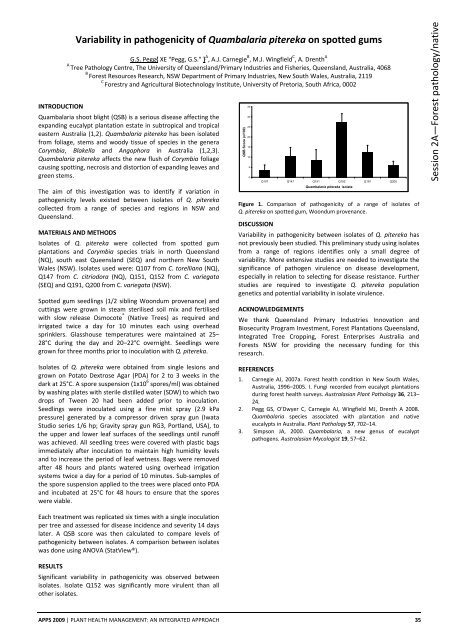View PDF - Australasian Plant Pathology Society
View PDF - Australasian Plant Pathology Society
View PDF - Australasian Plant Pathology Society
You also want an ePaper? Increase the reach of your titles
YUMPU automatically turns print PDFs into web optimized ePapers that Google loves.
INTRODUCTION<br />
Variability in pathogenicity of Quambalaria pitereka on spotted gums<br />
G.S. Pegg{ XE "Pegg, G.S." } A , A.J. Carnegie B , M.J. Wingfield C , A. Drenth A<br />
A<br />
Tree <strong>Pathology</strong> Centre, The University of Queensland/Primary Industries and Fisheries, Queensland, Australia, 4068<br />
B<br />
Forest Resources Research, NSW Department of Primary Industries, New South Wales, Australia, 2119<br />
C<br />
Forestry and Agricultural Biotechnology Institute, University of Pretoria, South Africa, 0002<br />
Quambalaria shoot blight (QSB) is a serious disease affecting the<br />
expanding eucalypt plantation estate in subtropical and tropical<br />
eastern Australia (1,2). Quambalaria pitereka has been isolated<br />
from foliage, stems and woody tissue of species in the genera<br />
Corymbia, Blakella and Angophora in Australia (1,2,3).<br />
Quambalaria pitereka affects the new flush of Corymbia foliage<br />
causing spotting, necrosis and distortion of expanding leaves and<br />
green stems.<br />
The aim of this investigation was to identify if variation in<br />
pathogenicity levels existed between isolates of Q. pitereka<br />
collected from a range of species and regions in NSW and<br />
Queensland.<br />
MATERIALS AND METHODS<br />
Isolates of Q. pitereka were collected from spotted gum<br />
plantations and Corymbia species trials in north Queensland<br />
(NQ), south east Queensland (SEQ) and northern New South<br />
Wales (NSW). Isolates used were: Q107 from C. torelliana (NQ),<br />
Q147 from C. citriodora (NQ), Q151, Q152 from C. variegata<br />
(SEQ) and Q191, Q200 from C. variegata (NSW).<br />
Spotted gum seedlings (1/2 sibling Woondum provenance) and<br />
cuttings were grown in steam sterilised soil mix and fertilised<br />
with slow release Osmocote ® (Native Trees) as required and<br />
irrigated twice a day for 10 minutes each using overhead<br />
sprinklers. Glasshouse temperatures were maintained at 25–<br />
28°C during the day and 20–22°C overnight. Seedlings were<br />
grown for three months prior to inoculation with Q. pitereka.<br />
QSB Score (x/100)<br />
35<br />
30<br />
25<br />
20<br />
15<br />
10<br />
5<br />
0<br />
Q107 Q147 Q151 Q152 Q191 Q200<br />
Quambalaria pitereka isolate<br />
Figure 1. Comparison of pathogenicity of a range of isolates of<br />
Q. pitereka on spotted gum, Woondum provenance.<br />
DISCUSSION<br />
Variability in pathogenicity between isolates of Q. pitereka has<br />
not previously been studied. This preliminary study using isolates<br />
from a range of regions identifies only a small degree of<br />
variability. More extensive studies are needed to investigate the<br />
significance of pathogen virulence on disease development,<br />
especially in relation to selecting for disease resistance. Further<br />
studies are required to investigate Q. pitereka population<br />
genetics and potential variability in isolate virulence.<br />
ACKNOWLEDGEMENTS<br />
We thank Queensland Primary Industries Innovation and<br />
Biosecurity Program Investment, Forest <strong>Plant</strong>ations Queensland,<br />
Integrated Tree Cropping, Forest Enterprises Australia and<br />
Forests NSW for providing the necessary funding for this<br />
research.<br />
Session 2A—Forest pathology/native<br />
Isolates of Q. pitereka were obtained from single lesions and<br />
grown on Potato Dextrose Agar (PDA) for 2 to 3 weeks in the<br />
dark at 25°C. A spore suspension (1x10 6 spores/ml) was obtained<br />
by washing plates with sterile distilled water (SDW) to which two<br />
drops of Tween 20 had been added prior to inoculation.<br />
Seedlings were inoculated using a fine mist spray (2.9 kPa<br />
pressure) generated by a compressor driven spray gun (Iwata<br />
Studio series 1/6 hp; Gravity spray gun RG3, Portland, USA), to<br />
the upper and lower leaf surfaces of the seedlings until runoff<br />
was achieved. All seedling trees were covered with plastic bags<br />
immediately after inoculation to maintain high humidity levels<br />
and to increase the period of leaf wetness. Bags were removed<br />
after 48 hours and plants watered using overhead irrigation<br />
systems twice a day for a period of 10 minutes. Sub‐samples of<br />
the spore suspension applied to the trees were placed onto PDA<br />
and incubated at 25°C for 48 hours to ensure that the spores<br />
were viable.<br />
REFERENCES<br />
1. Carnegie AJ, 2007a. Forest health condition in New South Wales,<br />
Australia, 1996–2005. I. Fungi recorded from eucalypt plantations<br />
during forest health surveys. <strong>Australasian</strong> <strong>Plant</strong> <strong>Pathology</strong> 36, 213–<br />
24.<br />
2. Pegg GS, O’Dwyer C, Carnegie AJ, Wingfield MJ, Drenth A 2008.<br />
Quambalaria species associated with plantation and native<br />
eucalypts in Australia. <strong>Plant</strong> <strong>Pathology</strong> 57, 702–14.<br />
3. Simpson JA, 2000. Quambalaria, a new genus of eucalypt<br />
pathogens. <strong>Australasian</strong> Mycologist 19, 57–62.<br />
Each treatment was replicated six times with a single inoculation<br />
per tree and assessed for disease incidence and severity 14 days<br />
later. A QSB score was then calculated to compare levels of<br />
pathogenicity between isolates. A comparison between isolates<br />
was done using ANOVA (Stat<strong>View</strong>®).<br />
RESULTS<br />
Significant variability in pathogenicity was observed between<br />
isolates. Isolate Q152 was significantly more virulent than all<br />
other isolates.<br />
APPS 2009 | PLANT HEALTH MANAGEMENT: AN INTEGRATED APPROACH 35







![[Compatibility Mode].pdf](https://img.yumpu.com/27318716/1/190x135/compatibility-modepdf.jpg?quality=85)









